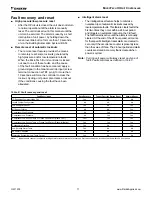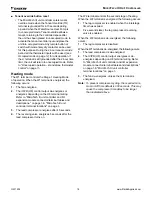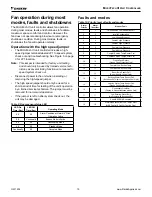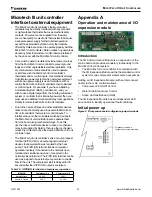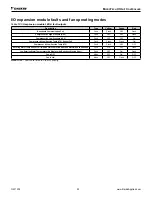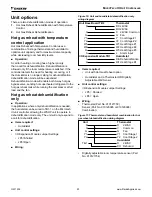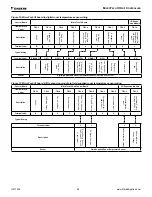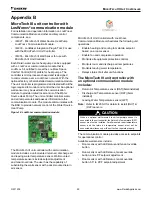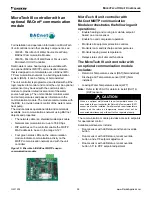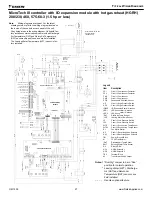
OM 1239
12 www.DaikinApplied.com
Dehumidification
•
Hot gas reheat with temperature control
–
Uses a combination of 2-stage thermostat and
humidistat to optimize unit capacity and for
maximum latent capacity while decreasing room
humidity levels. On a call for cooling, the fan will
energize, the pump request will energize, the
45 second flow timer will start. After the flow,
compressor minimum off, and random startup
timers are expired, the lead compressor will
start. If the room setpoint temperature is still not
satisfied, the lag compressor will be energized
as the stage 2 cooling settings. When the
room temperature conditions are satisfied, the
compressors will shut off and the fan will operate
according to its "fan only" setting when enabled
for continuous fan operation. If fan cycling is
enabled, the fan will turn off, once room setpoint
conditions are satisfied.
Available operating modes
•
Occupied
– The MicroTech III unit controller
will manage occupied and unoccupied modes
of operation. The occupancy mode can
be established by a BACnet or
L
on
W
orks
communication signal, from a room sensor
equipped with “Occupied/Unoccupied” mode
functions, or a thermostat equipped with an
“Occupied/Unoccupied” mode switch. When in
the occupied mode, the unit will be controlled to
its occupied setpoint conditions. The occupancy
state will be displayed on sensors equipped with
“Occupied/Unoccupied” mode functions and
annunciation capabilities.
•
Unoccupied
– When operating in the unoccupied
mode, the unit will be controlled to its unoccupied
setpoint conditions and the fan will cycle
according to a call for cooling, dehumidification
or heating. A simple “grounded” signal between
terminals U and C on the MicroTech III unit
controller will place the unit into the unoccupied
mode for night setback operation. The occupancy
state will be displayed on sensors equipped with
“Occupied/Unoccupied” mode functions and
annunciation capabilities.
•
Override
– A momentary (4 to 9 seconds) press
of the “Override” button on the thermostat or
room sensor during the unoccupied mode will
cause the unit to operate in the occupied mode
for two hours, for after-hours heating, cooling or
dehumidification. “OVERRIDE” will be displayed
on sensors equipped with override button and
annunciation capabilities.
•
Standby mode
– BACnet or
L
on
W
orks
units
can receive a signal from the Building Automation
System (BAS) to initiate the energy savings mode.
This mode is typically initiated by the BAS with
smart grid technologies to save energy. The savings
is driven by reducing peak electrical demand for
the building. Once initiated, the MicroTech III unit
controller will reset its effective setpoint to minimize
the stage of compressor operation. “E-SAVE” will be
displayed on sensors equipped with bypass mode
annunciation capabilities.
•
Emergency unit shutdown
– A simple grounded
signal puts the unit into the shutdown mode.
Remote shutdown is provided so that when
properly connected to a water loop controller or
remote switch, the emergency shutdown input
can be used to shut down the water source
heat pump. Compressor and fan operations are
suspended, and an a unique two external LED
status is generated.
MicroTech III unit protection
The control inputs are High Pressure (HP1/HP2), Low
Pressure (LP1/LP2), Suction Line Temperature Sensor
(SLTS1/SLTS2), Condensate Overflow (COF), freeze
fault, Unoccupied (U), and Remote Shutdown (E). The
control inputs are in normal states during occupied mode.
The state of each control in occupied mode during normal
operation is as follows:
•
High pressure (HP1/HP2):
Normally closed
switch that opens on a high refrigerant pressure
condition. Control will generate a high pressure fault
and disables the compressor output on the circuit
where the switch is open. Upon a failure of the
lead compressor, it will be "fail replaced" by the lag
compressor if available.
•
Low pressure (LP1/LP2):
Normally closed switch
that opens on a low refrigerant pressure condition.
Control will generate a low pressure fault on the
circuit where the switch is open.
•
Short cycle protection & random start –
After
power cycle or deactivation of certain alarms,
or when leaving the unoccupied mode, a new
random compressor start-delay time between 300
and 360 seconds is generated. The random start
timer prevents compressors in different units from
starting simultaneously. Compressor minimum
OFF 360 sec) and compressor minimum ON (180
sec) timers prevent compressor short cycling.
•
Suction line temperature sensor (SLTS1/SLTS2)
:
The control module will monitor the SLT sensor and
if the refrigerant temperature drops below the low
temperature limit set point, the controller will go into
the low temperature fault mode.
M
ICro
t
eCh
III u
nIt
C
ontroller

















